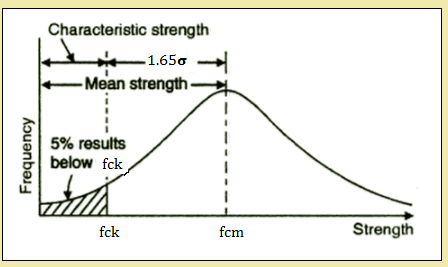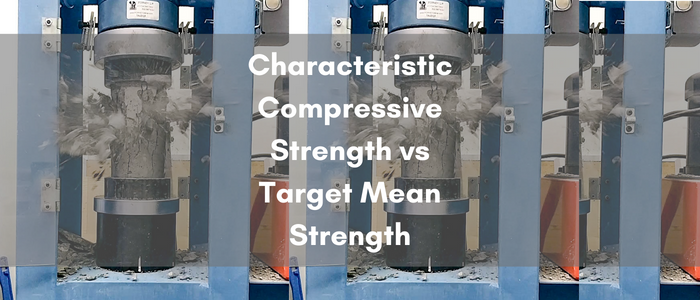Let us now differentiate between the Characteristic Compressive Strength and the Target Mean Strength.
Characteristic Compressive Strength
When we define the compressive strength of concrete mix, we define it in terms of what we call “characteristic compressive strength”, which is the strength of concrete specimens (cubes or cylinders depending on the code you are following) measured at age of 28 days (denoted as Fc’ or Fck). It is expected that when all specimens are tested at 28 days, not more 5% of the compressive strength results will fail below the characteristic compressive strength.
If you look at the below figure, you will notice that the results of compressive strength testing for all specimens follow the bell shape (normal distribution curve or Gaussian Distribution). The horizontal axis represents the compressive strength results, where are the vertical axis refers to the frequency, which is the number of specimens that have the same strength on the horizontal axis.

The results following the bell curve means that not all results obtained are the same. There is some difference between the results and thus, a standard deviation. The less the standard deviation is, the better is the concrete.
Target Mean Strength
The average value of the strength which lies in the middle of the previous bell curve (Fcm) is the mean strength and also, what we call the target mean strength.
When we design the concrete mix from the beginning, we do not do this for the characteristic strength. We tend to increase the value a little bit to account for any reductions in strength that might happen for our concrete.
Thus the target mean strength is larger than the characteristic compressive strength with a value that is equal to 1.65 * standard deviation of results (in other words, 1.65*𝛔)
The equation is:
Target mean strength = characteristic compressive strength + 1.65 * standard deviation
It depends on the code you are following, you might find different cases to calculate the standard deviation based on the available data of the previous concrete mixtures.
